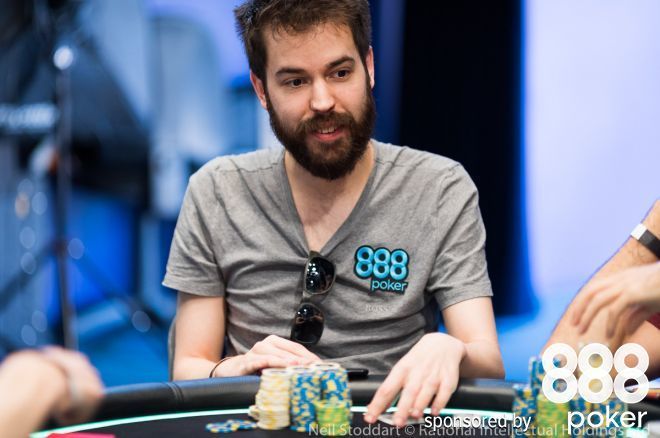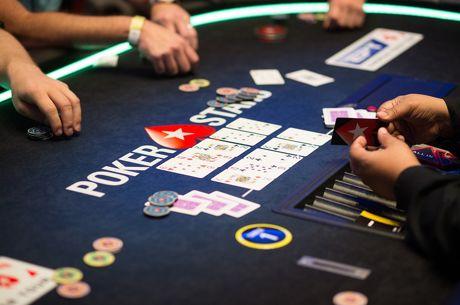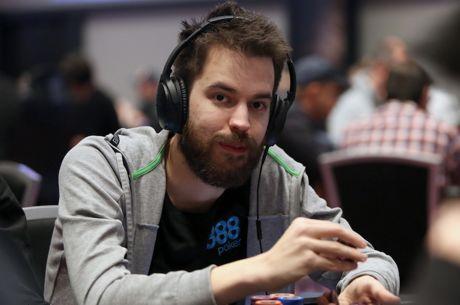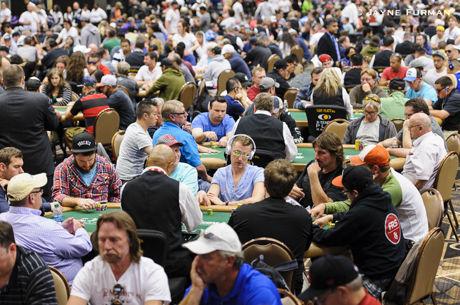Comparing Hand Ranges When Considering Whether to Bluff Catch

I played an interesting hand recently in the PokerStars and Monte-Carlo?Casino EPT �100K Super High Roller, one that illustrates how bluff catching involves not just suspecting your opponent is bluffing, but also recognizing whether or not the cards you hold make it more or less likely your opponent might be bluffing.
It was a few hours into Day 2 of the tournament and we had been losing players much more quickly than anticipated. I believe there were only two tables left, with the top six players making the money. I had built my stack to just under 1 million with the blinds 5,000/10,000 (with the 10,000 big blind ante), so I had nearly 100 BBs with which to work.
Preflop
Christoph Vogelsang, my chief opponent in this hand, was the table's chip leader. Christoph is obviously a very good player, and had been playing a lot of hands when he opened from the cutoff with me on the button, Nick Petrangelo in the small blind, and Ali Reza Fatehi in the big blind.
I assumed Christoph's opening range from the cutoff was quite wide, roughly 38-40 percent of hands. That would include any Ax-suited and Kx-suited hands, Q4-suited or Q5-suited and higher, J5-suited or J6-suited and higher, as well as all the lower suited gappers and a few other hands. You never know precisely in game what hands appear at the bottom of a 40 percent raising range, but that's an approximation.
When facing such a wide opening range, I've already got a game plan in mind from the button that includes considering how often I want to three-bet or call. I'll go ahead and reveal my hand �� KxQx (with no heart). With this hand you can't go wrong whether calling or three-betting. In this case I decided to call, but other times I can certainly see myself reraising.
I might add that with Ali (a recreational player) in the big blind, it was more likely perhaps for me just to call. The fact is, there are lots of strategic arguments that apply here. Some will say in this instance you're supposed to three-bet, say, 10-15 percent of the time, while others might chime in that with a recreational player in the blinds you only want to reraise 6-7 percent of the time.
But doing that would mean only reraising with good hands which in turn makes it possible for the cutoff to raise more often to fold you out, meaning you get to pay the button less often (which is obviously less profitable for you). Also, if you're playing too passively you let the cutoff see more flops with lesser hands, which you also can't do.
All of which is to say you need to find a balance in these spots, and be willing to three-bet whether or not there is a recreational player in the big blind whom you might want to keep in the hand.
The Flop
Ali did come along as well from the big blind, and the flop came Q?J?4?. Ali checked, then Christoph thought for a bit (as he does) before making a continuation bet of about 40 percent of the pot.
That's a fine play by Christoph. Personally I'd probably tend to check this flop a lot of the time, considering how the button's range includes a lot of Broadway cards. Indeed, here this flop probably hits my range more than both Christoph's range or Ali's range.
Given that circumstance, when Christoph bet, then, I did think he wouldn't do that too widely �� he probably had something, including, say, hands like T9 or AT as well as hand with hearts. He could also have aces, kings, QJ, 98, or Q4-suited (the bottom of his range).
I was happy with my hand and glad to call Christoph's c-bet. I was also glad to see Ali fold behind me.
The Turn
I should note that when I called the flop I was already thinking about subsequent streets. You should always have a plan, of course, and here in a tournament with a 30-second "shot clock," when I call the flop I already have to be thinking about what I am going to do on the turn and river.
In this case, I'm thinking in particular about my KxQx and hands with which I could bluff catch. I mentioned how my hand did not include a heart �� that becomes meaningful when the flop brings two hearts, since that gives Christoph more potential flush draws than would be the case if I did.
The turn was the 9?, an interesting card that I'm not sure is better for him or for me. In the moment, I thought it was better for me given that I could have all the KT-offsuit hands, a bunch of QJ hands, J9-suited and Q9-suited, as well as pocket fours.
This time Christoph bet around 60 percent of the pot. Now he could have T8-suited or even KT, although I have a king which reduces his straight combos. Indeed, if a ten comes on the river I make a king-high straight. So I still have equity against hands like J4, Q4, Q9, and J9. I can certainly call a 60 percent pot bet here, which is what I did.
The River
The river brought the 4?, making the final board Q?J?4?9?4?. That meant the flush draw bricked as did some of the straight draws. Christoph then made a big bet �� 1.5 times the pot �� and I had to think about what to do.

I like Christoph's bet a lot. He's well aware that he's the only one who can have pocket jacks or pocket queens. He also the only one here who can have Q4-suited. He also realizes, importantly, that over on the button I am pretty much capped at having KT or, possibly, pocket fours. The only way I get to the river with a good hand here is with those hands. In other words, it's very tough for me to have a hand here that can continue versus such a big river overbet.
Christoph choosing that sizing makes a lot of sense. He knows he's the only one who can have full houses. He can also make this bet with KT himself. Finally, we know each other pretty well, and Christoph knows that I'm capable of bluff catching �� that is, of calling with lesser hands, since I know he's capable of bluffing here.
The whole hand then comes down to what hands are good bluff catchers for me. I can't only call Christoph with big, strong hands �� he'll run me over if I do.
My KxQx without a heart is a good bluff catcher in part because it doesn't block Christoph's bluffs. My not having the K? in my hand means he could have a number of excellent hands with which to bluff that did contain the K? �� lots of K?X? hands. If I were in Christoph's shoes here and I had the K? in my hand, I could see myself running this bluff �� it would be a great play. Of course, the flip side is that he could also have a number of good value hands (such as the ones that make full houses).
Having a good bluff catcher as I did, I called. Alas, Christoph wasn't bluffing in this spot �� he had Q?4? for one of his few full house combinations
It's hard to say I played the hand right since I did say from the start Q4-suited could appear in Christoph's range. Then again, if you look at the board, he could only have exactly Q?4? or Q?4? �� just two combinations. In any case, Christoph played the hand very well, and deservedly went on to finish second in the event.
888poker Ambassador Dominik Nitsche has amassed over $14.6 million in lifetime tournament earnings to date, earning multiple titles on various tours. Among those wins are four in World Series of Poker bracelet events, including one in the �111,111 buy-in 2017 World Series of Poker Europe High Roller for One Drop.









